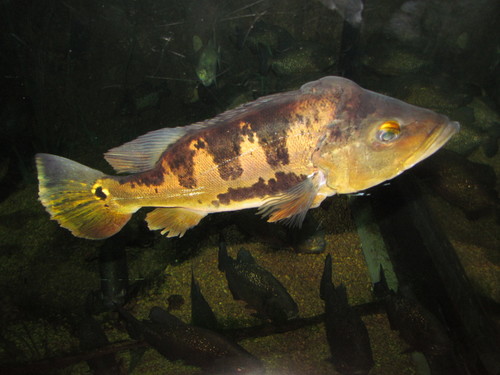
Peacock Bass
The Atlantic bluefin tuna (Thunnus thynnus) is a highly migratory, large pelagic fish renowned for its size, speed, and commercial value. It is a top predator in the marine ecosystem and plays a crucial role in maintaining the balance of ocean life. This species is prized for its meat, particularly in sushi and sashimi.
4 8 years
Lifespan
74 cm
Length
Least Concern
Conservation Status
20 km/h
Swimming speed
Carnivorous
Diet
Local Migration
Migration
Appearance Overview
The Atlantic bluefin tuna is a large, torpedo-shaped fish with a metallic dark blue dorsal side and a silvery-white underside.
Coloration
Dark metallic blue on top, silvery-white underside
Body Shape
Torpedo-shaped, streamlined for speed
Fins
Two dorsal fins, the first depressible; small finlets run from dorsal and anal fins to the tail
Keel
Strong lateral keel on the caudal peduncle
Length
Up to 13 feet (4 meters), commonly around 6.5 feet (2 meters)
Weight
Up to 2,000 lbs (907 kg), commonly around 550 lbs (250 kg)
Diet
Carnivorous, feeding on a variety of fish (such as herring, mackerel, and hake), squid, and crustaceans.
Feeding Behavior
Highly active predator, using its speed and agility to hunt. Often feeds cooperatively, herding prey into tight schools.
Social Behavior
Forms large schools, particularly during migration and spawning. Schools may be segregated by size.
Commercial Relevance
Extremely high value, particularly in the sushi and sashimi markets of Japan. Overfishing has led to significant population declines.
Conservation measures
International fishing quotas, minimum size limits, and time-area closures. Monitoring and research efforts are ongoing.
Status
Endangered (IUCN)
Threats
Overfishing (primarily for sushi and sashimi), bycatch in other fisheries, climate change affecting prey distribution and spawning grounds.
Habitat Distribution
Depth Range
0-1,000 meters (0-3,280 feet), most commonly in the upper 200 meters (656 feet)
Geographic Range
Western and Eastern Atlantic Ocean, Mediterranean Sea
Preferred Environment
Temperate and subtropical waters; pelagic, open ocean environment
Reproduction and Life Cycle
Breeding Habits
Spawns in warm waters; western population spawns in the Gulf of Mexico, eastern population in the Mediterranean Sea. Spawning occurs in large aggregations.
Development Stages
Eggs are pelagic (free-floating). Larvae develop rapidly, feeding on plankton. Juveniles grow quickly, reaching significant size within the first year.
Fecundity
Highly fecund; a large female can produce up to 30 million eggs per spawning season.
Maturity Age
Maturity varies between populations; western Atlantic stock matures at around 8-12 years, eastern Atlantic stock at around 4-5 years.
Faqs about Peacock Bass
How fast can Atlantic bluefin tuna swim?
Atlantic bluefin tuna are among the fastest fish in the ocean, capable of bursts of speed up to 43 mph (70 km/h).
How long do Atlantic bluefin tuna live?
They can live up to 40 years, although this is becoming rarer due to overfishing.
Are Atlantic bluefin tuna warm-blooded?
Yes, they are warm-blooded, which allows them to maintain a higher body temperature than the surrounding water, aiding in muscle efficiency.
Do Atlantic bluefin tuna migrate?
They undertake long migrations across the Atlantic Ocean for feeding and spawning.
What is the biggest threat to Atlantic bluefin tuna?
Overfishing, driven by high demand in the sushi market, is the primary threat.
Where do Atlantic bluefin tuna spawn?
The western Atlantic stock spawns in the Gulf of Mexico, while the eastern Atlantic stock spawns in the Mediterranean Sea.
How can consumers help protect bluefin tuna?
Look for sustainable seafood certifications and avoid consuming bluefin tuna unless its source is verified as sustainable.
How valuable is a single bluefin tuna?
A single bluefin tuna can be worth tens of thousands, or even hundreds of thousands of dollars, at auction in Japan.
Where are Atlantic Bluefin tuna found?
They are found in both the western and eastern Atlantic Ocean, including the Mediterranean Sea.
Copyright @ Nature Style Limited. All Rights Reserved.
 English
English